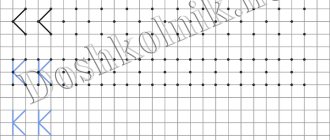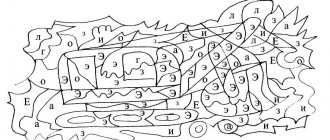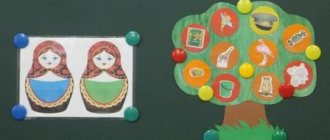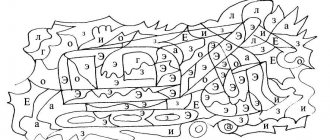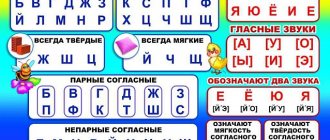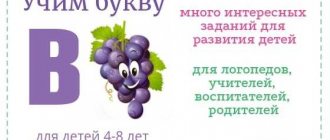The alphabet for young children is a set of incomprehensible symbols. To help your child learn the alphabet, you need to work with him on exercises designed specifically for preschool children. One of the most difficult letters to learn is the letter E: tasks for preschoolers aimed at learning it should be simple and interesting, and instructions for parents and teachers should be clear and effective.
The letter E is one of the most difficult letters for a child to learn the alphabet.
Goals and objectives
The main goal of the classes is for the child to master the rules for writing the letter E and the principles of using it in words of different parts of speech, as well as the development of recognition skills for this symbol.
Teaching a child to distinguish the letter E from others, to write it beautifully and legibly, to consciously use it in words, and to pronounce this sound correctly are the main tasks. It is advisable to arouse interest in learning letters with the help of fairy tales, poems, riddles and exciting games for preschoolers.
Learning the alphabet with young children is difficult, but if you conduct lessons on the topic “Letter E” correctly, then problems will no longer arise throughout the entire training.
Study Materials
Poetry
* * * Next will be the letter E, I’ll show you that too. The tall spruce is growing. The hedgehog is chewing blackberries. Grandfather is riding in a cart. He turned one hundred years old. A raccoon lives under a bush. Egor goes outside. (V. Lomovtsev)
Poems about the letter "E"
Puzzles
* * * The raccoon chews, the raccoon chews, He chews blackberries, And on the pink wall He draws a letter...
Riddles about the letter "E"
Tongue Twisters
* * * The letter E rides on a mare across the grass with a spruce tree. It rides for several weeks, E brings the spruce tree to Elena.
Tongue twisters starting with the letter "E"
Fairy tales
Introducing the letter E
It is better to start getting acquainted with the letter E by searching for the letter in the large alphabet. If you succeed the first time (preschoolers already know the previous letters), you can move on. Otherwise, you should help the children with a preparatory, simple poem:
We glue the sticks to the line: One, two, three... and the letter E. The letter E will remind us of the three-pronged comb. (Rein S.)
After listening to such a description, the children will easily find the letter E. It will be good if the children learn this poem by heart in order to better remember and pronounce the desired sound once again. For greater effect, combine repeating the poem with watching an interactive video.
The next stage of learning is to look at a sample of writing a letter. You can write down the desired symbol individually with each child or on the board for the whole group (this is how we teach children independence).
The letter has been studied, children can already distinguish it from others. The next task is to explain to them that E is spelled differently. The simplest and most proven way of explanation is the example of a family, where the large printed E is the father (the head of the family), the large capital E is the mother, and the small “e” is their child.
Task for preschoolers: printed letter E
It is difficult for young children to perceive information only by ear, so it is better to do exercises that also involve eye contact with objects.
Exercise 1
Write E and E in three different colors, for example red, blue, green.
Task 2
Give examples of 3 animals whose names begin with E. Suitable words: raccoon, echidna, unicorn.
Task 3
Name three words starting with E. For example, Christmas tree, ruff, hedgehog.
In one of the tasks, the child must say a word starting with Yo, for example Hedgehog.
Task 4
Circle all the E and E in the presented row: A c g v E l e v Sh f m i E y c e f X S F sh k e e k.
Task 5
Name three names that have E in them.
Task 6
Make up five words that contain E.
Task 7
Determine the place of the given sound in the listed words: eve, spruce, bear, hay, foam, hedgehog.
Summary of a literacy lesson in the preparatory group “Letter E, sound [E]”
Abdulova Dzhume Sirazhutdinovna
Summary of a literacy lesson in the preparatory group “Letter E, sound [E]”
Goal: to consolidate the concept of the letter E
Objectives: to introduce children to the letter E, to improve the skills of sound analysis of words, to consolidate the visual image of the letter, to develop phonemic hearing, memory, and attention.
Materials: demonstration material, workbooks part 2, a simple pencil, colored pens and pencils, tumblers, felt-tip pens.
I. Organizational moment
Educator: Let's remember all the vowel sounds and do gymnastics for our lips.
A vowel is a sound that is pronounced unhindered: none of the organs of the articulatory (speech) apparatus is an obstacle to its pronunciation.
Vowel sounds can be pronounced for a long time, even sung: a-a-a., u-u-u. There are only six vowel sounds: A, O, U, I, Y, E. (exercise being performed)
Educator: We have already studied these sounds and letters. But there are more vowel letters in the Russian language than vowel sounds - there are 10 of them. The fact is that in the Russian alphabet there are iotated vowel letters. Each letter can represent one or two sounds. These letters represent two sounds in the following positions:
- at the beginning of a word
- after a soft sign
- after a hard sign
- after a vowel
In the back pocket there are tumblers with an asterisk (*) - vowels of the second row. Vowels of the second row of the magic letter. This is because they soften the preceding consonants
Educator : -Guys, today we will get acquainted with the letter –E-, denoting the vowel sound –E-ye-. This tricky sound when pronounced produces not one, but two sounds -E-ye-, for this reason the letter -E- is nicknamed greedy because when pronounced it has two sounds.
Educator: -Try to pronounce the sound –E-ye-.
Educator: You hear not one, but two sounds
Educator : the sound -E-ye- vowel, when pronouncing the sound -E-ye- - the teeth are brought together in a smile, the lips are close to the teeth, the tip of the tongue is behind the lower incisors, the air stream goes through the mouth; the vocal cords are tense, as a result of which a voice is formed and I pronounce the sound - E-ye
Educator: Today the one whose name begins with E will go to the board. That’s right, this is our Eva
II. Main part.
1. Game exercise “Put the letter in her apartment”
Objectives: consolidate knowledge about the studied sound and letter; learn to choose the right and left front house, count the floors in order, starting from the bottom; explain the choice of your decision based on knowledge about sound.
Educator: Eva, determine the place of the given sound in the word (at the beginning, in the middle, at the end of the word);
- Fill in the corresponding cell in the diagram under the picture with the color we use to denote this sound
Educator: you and I have two red tumblers. A tumbler with an asterisk for the vowels of sorceresses, which soften the preceding consonants; we will place them in the second row of the house. And vowels that do not soften the preceding consonants will be written in the first row
Educator: which tumbler we choose (red).
Children's answers : red with an asterisk
Educator : why red with an asterisk?
Children's answers: Because the letter E softens the consonants and when pronounced it has two sounds.
Educator: That's right, we take the colored letter E from the owner's pocket and place it on the right on the second floor, next to the letter E. And now, we do it from our notebooks. (Work in the notebook Elena Astafieva: We play, read, write. Workbook No. 2. Federal State Educational Standards) children write the letter E., paint the roof of the house and the tumbler in red, write the letter E in their pocket.
Educator: Determine the place in the word (at the beginning, in the middle, at the end of the word); Explain why you wrote the letter in this particular color?
Eve:
Spruce
-E-vowel, located at the beginning of the word, written in red
Broom-
E is a vowel, located in the middle of a word, written in red
Dress
–E-vowel, located at the end of the word, written in red
Educator : - Draw objects with the given sound yourself (in the empty cells on the right); - Show on the diagram under each picture the place in the word and its characteristics (beginning, middle or end of the word) and I will write the letter
Eva : E-vowel, located at the beginning of the word, written in red
Egor
E-vowel, located at the beginning of the word, written in red
Chalk-
E-vowel, located in the middle of the word, written in red
Educator: Well done guys, you did it all
2. Game exercise “Continue according to the example”
Goals: consolidate knowledge about the letter. Training a child's visual memory
3. Exercise “Continue the ornament”
Goal: continue according to the example; develop visual memory
4. Exercise “Finish the drawing”
Goal: develop hand motor skills
5. Game “What kind of rivers are these?” (Rebuses)
Goals. We train the ability to solve various types of puzzles. We reinforce the child’s knowledge of the rule about writing the names of rivers with a capital letter. We train in composing sentences for a given scheme, performing sound-letter analysis and synthesis. We consolidate knowledge about our hometown and its rivers. Progress of the game. The child consistently solves puzzles, signs the guess words and analyzes them, following sound and syllable patterns. The adult asks the child to explain (or explains himself what each word means (Neva, Moika, Fontanka), draws the child’s attention to the fact that the names of rivers are written with a capital letter. The child analyzes the sentence diagram and fills in the missing words: Neva, Moika, Fontanka are rivers (Here the child himself remembers the rule for writing the names of rivers with a capital letter.)
6. "My Hometown"
Goals. We learn to correctly write the name of our hometown (St. Petersburg). Using this word as an example, we develop the ability to perform sound-letter analysis and synthesis, using knowledge about the function of the letter E. We train the ability to analyze a sentence by the number of words. We consolidate knowledge about writing the first word in a sentence and the names of cities with a capital letter, about placing a punctuation mark (period) at the end of a sentence.
Progress of the game . With the help of an adult, the child performs a sound-letter analysis of the word Petersburg, inserts the missing letters, generalizes them (vowels); After reading the sentence, he carries out its diagram, commenting on his actions. It is necessary to pay attention to the child’s explanations about the spelling of the words Moy and Petersburg with a capital letter. In conclusion, the child traces or draws one of the monuments of his hometown and talks about this monument.
7. Game "Travelers"
Goals. We develop the skill of syllable reading. When reading, we achieve a smooth transition from syllable to syllable. We consolidate knowledge about writing city names with capital letters.
We develop sound-letter analysis by continuing to train the child in selecting a sound pattern for a word. We consolidate knowledge about the letter E [ye]: softening the previous consonant and designating two sounds at the beginning of a word (Yerevan).
Progress of the game. The child reads the names of cities using arrows, orally performing their sound analysis; selects a sound pattern corresponding to the given name, writes this word above the selected pattern and colors the pattern. (The child's comments on writing the names of cities with a capital letter are necessary.) You can invite the child to remember Russian cities whose names contain the letter E (Elets, Belgorod, Zelenogorsk, Chelyabinsk, etc.).
Bottom line
-How many vowels are there in a sound?
-How many vowels are there in the alphabet?
-Which letter did we study?
-Whose name begins with this letter?
Educator:
Find out names starting with this letter, at home with your parents, and the letter E will be looking forward to them tomorrow morning.
Everyone did very well.
Tales about the letter
E is the sixth, which means that A, B, C, D and D are already in stock. It is important to use them in small fairy tales, so that children will repeat the material they have studied.
The letters children learn should be used in fairy tales.
Tale 1
Once upon a time there lived E, she was friends with everyone, helped everyone, if necessary, replaced them in letters. When B fell ill, there was no one to sit on the pipe, good E had to lean against the fence, and they began to look like brothers.
Another friend of ours, who was in trouble, asked to replace him in the word “school”, because he was the first in the list. Kind E came to the rescue here too, lay down on her back and became exactly like Sh.
Following her, T did not have time to fall into place in the word “trampoline.” Then, to help her read and write, E put all her legs and arms in one line and became like T. All together they fell into the right places, and the word formed correctly. So they brought a holiday to the children.
This fairy tale is over, but whoever listened - well done!
Fairy tale 2
Words live in the dictionary, in their own homes - their own sections.
E decided to go visit A. In the morning she set off on a long journey: through mountains, forests, rivers. And in order not to get lost, sister E, E, gave her one of her two balls. And E set off on her difficult journey.
A ball rolls through the forest, E can barely keep up with it, and in the dictionary winter begins, everyone ate in ice sparkles, windows in painted patterns. And the Christmas trees - they seem similar to each other to us. The letter E goes further and further and admires the beauty of the winter forest.
The letter E walks through the winter forest.
And suddenly someone picks up a dictionary and starts turning the pages. The whole alphabet is in a panic, because if the letters are not in place, the words cannot be found and you can confuse them all: raccoon, and hedgehog, and ruff, and Christmas tree.
We need to save the alphabet, we need to return E to its place. To do this you need to say a special word. Only the hedgehog knew him. Then everyone gathered and unanimously asked: “Hedgehog, say the word.” He agreed, and E returned to her seat just as the last page turned.
Funny poems about the letter E for children
A clown is riding along the highway on a shiny wheel. For what? For what? - Just for fun! Wish me success. (V. Berestov)
Under the flower, the mother hedgehog began to bathe the hedgehog. Dew drips, drips onto faces, onto eyes. The mother hedgehog will not understand. How to wash their backs. And the hedgehogs walk around with dirty backs for a day or two. At least sit and wait a month. So that the rains begin to fall. Be glad you guys. Not prickly hedgehogs. (G. Vieru)
Blackberry The berry looks good, But go ahead and pick it. All covered in thorns, like a hedgehog. That's why blackberries. Blackberry, blackberry! Oh, so many! Look! Don't be shy, Eat, baby. Afterwards you will treat your mother. We ate blackberries and wanted to catch a sturgeon in the river between the reeds, but we caught three ruffs. (S. Marshak)
The spruce tree in the hollow is hiding something. There is a house for a raccoon there. (B. Timofeev)
The raccoon will not eat until His food is washed. His assistant is the river: It rinses the food and rubs it lightly. And then he eats to his fill. The raccoon is a lover of cleanliness. He doesn’t eat anything unwashed... What about you? (V. Lunin)
Blackberry-strawberry (berry patter) If you haven’t lived Near a blackberry tree. But if you lived Near a strawberry field, - That means you are familiar with strawberry jam, and not at all with the familiar blackberry jam. But if you lived Near the blackberry tree, And if you did not live Near the strawberry tree, That means you are familiar with blackberry jam, and not at all with the familiar strawberry jam. But if you lived Near a blackberry tree, And if you lived Near a strawberry tree, And if you didn’t spare time in the forest, That means excellent blackberry jam. You ate strawberry jam every day. (M. Yasnov)
If a raccoon climbed into a blackberry. We can barely save him from the needles. If the hedgehog climbed into the blackberry, then it is still unknown. Who will win. The raccoon has no need for summer. He bares his teeth in the sun. It's not sweet on a hot day. Who doesn't take off their fur coats? (Ya. Akim)
There is a raccoon, and the raccoon has a raccoon coat. The animals are chilly, but you can’t find him through his fur coat, neither the snowstorms nor the cold. Know he lives for himself, does not grieve! (A. Pudval)
This little animal is quite harmless. True, her appearance is not enviable. People called the poor thing echidna. People, come to your senses! Shame on you?! (B. Zakhoder)
